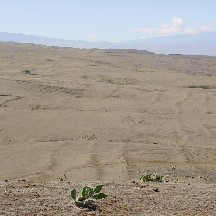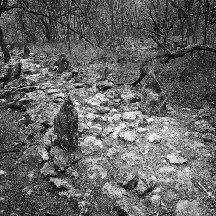Digital Collections
Celebrating the breadth and depth of Hawaiian knowledge. Amplifying Pacific voices of resiliency and hope. Recording the wisdom of past and present to help shape our future.
Kēhau Abad
April 2004
Being at many wahi kūpuna is much like hearing an ancient oli offered once more and feeling it resonate in the depths of your na‘au. There’s a direct connection that’s made between kūpuna of generations long past and those of us here today—no museum glass cases between the generations, no Western interpretations or translations intervening. Wahi kūpuna often make profound statements on their own—echoes from the actions of kūpuna kahiko. As all of our senses soak in a site, haunting refrains come through.
An incredible paved coral ala (pathway) runs through an otherwise fairly typical stretch of undeveloped land in Kalaeloa, Honouliuili, O‘ahu. Its voice still speaks clearly though little is formally known about it. The remaining portion of the path is only about 1,400 feet long. What’s phenomenal and unique about this ala is that at each interval of about six feet along its length are paired upright coral stones standing from two to three feet high, one on each side of the path. The upper portions of the uprights are generally triangular in appearance and seem in many if not all cases to have been humanly shaped to take on that characteristic form, the same form used for uprights at some heiau. The ala was undoubtedly kapu, most likely both a function of who traveled upon it and what could be found at one or both ends of it.
Though no record exists of the name, age, or point of origin or destination of this ala, much about those who built it is clear. The kānaka who created it had tremendous reverence for the kapu of the ali‘i, akua, and places associated with the ala, so much so that they invested tremendous mana in the form of their labor to create this sacred pathway. These were creative, innovative, and expressive people who sought to improve upon what came before. They took great pride in what they produced and were expert in executing their craft. And hence, even through today, these kānaka have our honor and respect.
If the ala chants to us a singular and personal oli praising the character of those who created this sacred pathway in Kalaeloa, the dryland field system of Kona and Kohala resounds with a booming chorus of thousands upon thousands of voices. As the sun rises or sets and its rays cast shadows against the stone-and-earth embankments surrounding each rectangular field plot, the innumerable continuous plots form what seems like a vast net draped over the land as far as the eyes can see.
This agricultural wonder is arguably the largest site in all of Hawai‘i, extending from North Kohala through South Kona. The size of the North Kohala portion alone is approximately 12 by 2.5 miles. This field system was perhaps begun around the era when the political center of Hawai‘i shifted from Waipi‘o to Kona. Mahi‘ai who farmed these plots primarily grew ‘uala (sweet potato). Through the generations they expanded and elaborated the system, as fields were dissected into smaller plots, more trails and borders added throughout the system, and additional features included to help retain moisture in the soil and buffer the plantings from the wind.
No ‘uala grows there now, but if you stand on any of the many pu‘u that adorn the landscape and you look out at the expanse of what was once under cultivation, a beautiful mele honoring the kūpuna of that region can be heard. It tells of an industrious, large, and well-fed populace. It praises respected, capable, and efficient ali‘i who organized their people in this phenomenally coordinated endeavor. It hails the ingenuity of expert mahi‘ai who recognized how best to make the land flourish. Its refrain celebrates a prosperous lāhui.
The voices in this mele from the uplands of Kohala and Kona reverberate in unison. The voices streaming from Keolonāhihi at Kamoa Point, Hōlualoa, Kona are varied, complex, and intricately harmonized. Keolonāhihi is a chiefly complex like no other. The walled area that defines its formal space extends over 250 yards running parallel to the main shoreline and about 125 yards in the ma uka to ma kai direction. It includes a large number of separate use areas delineated by pavements, walls, platforms, terraces, and walkways.
Relying upon information from kūpuna of the area, Henry P. Kekahuna in 1950 recorded the uses of many of these components. Within the complex are five heiau—Hale o Kā‘ili was a luakini reserved for the highest order of political worship, Keolonāhihi was where ali‘i wāhine worshipped, Kānekaheilani was dedicated to akua of sports, Hale ‘A‘ama was for akua of surfing, and Hale o ke Kupua was associated with preparing chiefly iwi for burial. There were hale for ali‘i who stayed there as well as another for resident kāhuna. There was a hale where ali‘i wahine remained secluded during their periods. There were open areas dedicated to planting and two sports kahua, one where ali‘i engaged each other and another at the far southern end of Keolonāhihi where both ali‘i and maka‘āinana competed. A secured area that was essentially an enclosure within an enclosure contained a hale where young ali‘i wāhine were kept isolated. Seven springs within the complex each served particular purposes such as bathing, drinking, and ceremonial uses. Fronting Hōlualua Bay was a large raised platform situated perfectly for watching surfers. Just ma uka of that was a hālau for olo surfboards (long boards typically used by ali‘i), and adjoining that was another hālau for wa‘a. Further ma uka of that was a large hale where ali‘i gathered to enjoy feasts and entertainment.
The many structures that remain intact today within Keolonāhihi, and the rich descriptions that Kekahuna documented, allow us to imagine vividly the voices that would have enlivened the enclosure. People were confirming their responsibilities and commitments to their akua at heiau. At kahua they were teaching and learning the warfare skills necessary to protect a nation. Among kāhuna they were conferring about national dilemmas needing resolution. Among the young they spoke with admiration for the best of the role models to which they were being exposed. And in all quarters there were times and places to relish and extol the joys that were their passion. At Keolonāhihi there was focus, purpose, and balance—melodies and harmonies of life’s voices.
These are only a few examples of how visiting wahi kūpuna can provide each of us with precious opportunities to hear beautiful oli and mele of our kūpuna. Each wahi kūpuna has its own message. Go to them and listen carefully. The refrains will fill your thoughts, settle in your na‘au, and touch your soul.

A North Kohala portion of the leeward Hawaiʻi dryland field system.

Though no record exists of the name, age, or point of origin or destination of this ala, much about those who built it is clear. The kānaka who created it had tremendous reverence for the kapu of the aliʻi, akua, and places associated with the ala, so much so that they invested tremendous mana in the form of their labor to create this sacred pathway.